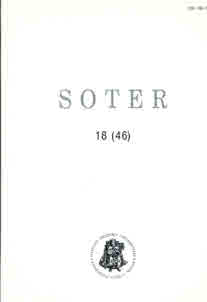Popiežiaus Jono Pauliaus II mokymo centre – Kristus
The teaching of pope john paul ii centers around Christ
Author(s): Algis BaniulisSubject(s): Christian Theology and Religion
Published by: Vytauto Didžiojo Universitetas
Keywords: popiežius Jonas Paulius II; Kristus; enciklikos; pope; John Paul II; Christ; encyclicals;
Summary/Abstract: This research aims at disclosing the most characteristic traits of Christ and showing the es sence of man’s relations to Christ in the light of teaching of Pope John Paul II. The tasks of the research are: first, to disclose the conception of redeeming Christ in the works of John Paul II; second, third, fourth and fifth, to state that Christ is the New and Final Adam, our way to the Father’s house, the sign of the mysterious God’s union with man, the mani festation of love and mercy. The method of research is analysis and synthesis. Although the Holy Father touches and analyses rather the work and social problems, he brings to light the christocentricity of these problems by showing Christ as a working man and evaluating man’s labor in the light of Christ’s cross and resurrection. The Pope wants to meet today’s man and converse with him – where he lives, what he loves and what he expects from his life. His teaching is the call to renew and strengthen our faith, our vital link age with Jesus Christ. The research has shown that in examining the works of the Holy Father John Paul II we discover his partic ular love and attention to Christ the Redeemer. Almost at every page we meet the mention of his salvific passion, the power of his cross, his great love as he reconciles us with the Father. The Pope also speaks about the history of salvation. It has to be emphasized, that in his works the historic consciousness of the Church is closely connected with believing in the one and triune God who through the salvation-carrying Word and the sending of the Holy Spirit came and continues to come to human society. The Holy Father brings to light the truth that the Son of God through his incarnation in a way connected himself with the destiny of every man. He discloses the human value of the mystery of redemption by stating that man cannot live without love. Without it he becomes a being incomprehensible to himself. His life be comes senseless if he does not meet love, does not experience it and does not share it. Precisely for that reason Christ the Redeemer perfectly manifests man to man himself. In the center of the mys tery of redemption stands Christ’s cross on Calvary. By the same token there is in it the invi tation to man, by giving himself to God, to participate in divine life and, as a co-heir of Christ, to reach love that is in God and flows from him. The eternal life as the result merited by Christ the Redeemer opens itself only after the endured death thanks to his resurrection. Death concludes the old existence; without this con dition new existence would not be possible. The first man Adam was the image of that future one who is the Lord Jesus Christ. Hence Christ is the New and Final Adam. He is the destroyer of Adam’s guilt. Because of the sin of our first parent Adam all his descendants became subjected to the rule of original sin. Now we become called to grace, called to love.
Journal: SOTER: religijos mokslo žurnalas
- Issue Year: 48/2006
- Issue No: 20
- Page Range: 23-37
- Page Count: 15
- Language: Lithuanian

